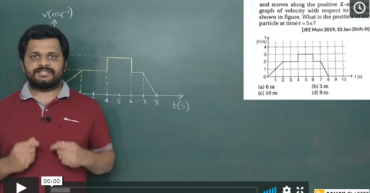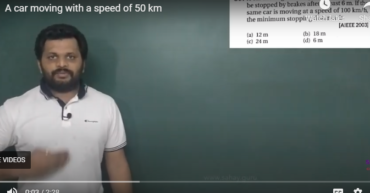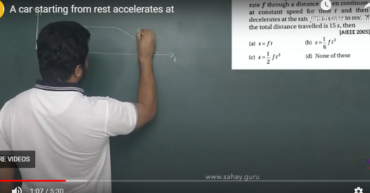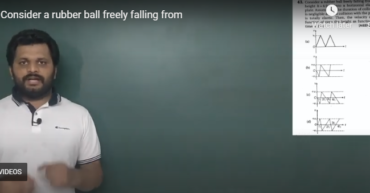JEE Mains Physics 2002-2019 Solved Video Solutions
A particle starts from the origin at time t = 0 and moves along the positive x – axis. The graph of velocity with respect to time is shown in figure. What is the position of the particle at time t = 5s?
16
Sep
A particle starts from the origin at time t = 0 and moves along the positive x – axis. The graph of velocity with respect to time is shown in figure. What is the position of the particle at time t = 5s? A river is flowing from west to east at a speed of [...]
A car moving with a speed of 50 km h^−1 can be stopped by brakes after atleast 6 m. If the same car is moving at a speed of 100 km h^−1 the minimum stopping distance is :
09
Sep
A car moving with a speed of 50 km h^−1 can be stopped by brakes after atleast 6 m. If the same car is moving at a speed of 100 km h^−1 the minimum stopping distance is : A car moving with a speed of 50 km h^−1 can be stopped by brakes after atleast [...]
An automobile travelling with speed of 60 km/h, can brake to stop within a distance of 20 m. If the car is going twice as fast, i.e. 120 km/h, the stopping distance will be:
09
Sep
An automobile travelling with speed of 60 km/h, can brake to stop within a distance of 20 m. If the car is going twice as fast, i.e. 120 km/h, the stopping distance will be: An automobile travelling with speed of 60 km/h can brake to stop within a distance of 20 m. If the car [...]
A car starting from rest accelerates at the rate f through a distance s, then continues at constant speed for time t and then decelerates at the rate f/2 to come to rest. If the total distance traversed is 15 s, then
09
Sep
A car starting from rest accelerates at the rate f through a distance s, then continues at constant speed for time t and then decelerates at the rate f/2 to come to rest. If the total distance traversed is 15 s, then A car starting from rest accelerates at the rate f through a distance [...]
Consider a rubber ball freely falling from a height h = 4.9 m onto a horizontal elastic plate. Assume that the duration of collision is negligible and the collision with the plate is totally elastic. Then the velocity as a function of time and the height as a function of time will be :
09
Sep
Consider a rubber ball freely falling from a height h = 4.9 m onto a horizontal elastic plate. Assume that the duration of collision is negligible and the collision with the plate is totally elastic. Then the velocity as a function of time and the height as a function of time will be : All [...]
From a tower of height H, a particle is thrown vertically upwards with a speed u. The time taken by the particle, to hit the ground, is n times that taken by it to reach the highest point of its path. The relation between H, u and n is:
09
Sep
From a tower of height H, a particle is thrown vertically upwards with a speed u. The time taken by the particle, to hit the ground, is n times that taken by it to reach the highest point of its path. The relation between H, u and n is: a particle is thrown vertically upwards [...]
Two stones are thrown up simultaneously from the edge of a cliff 240 m high with initial speed of 10 m/s and 40 m/s respectively. Which of the following graph best represents the time variation of relative position of the second stone with respect to the first? (Assume stones do not rebound after hitting the ground and neglect air resistance, take g = 10 m/s^2
09
Sep
Two stones are thrown up simultaneously from the edge of a cliff 240 m high with initial speed of 10 m/s and 40 m/s respectively. Which of the following graph best represents the time variation of relative position of the second stone with respect to the first? (Assume stones do not rebound after hitting the [...]
All the graphs below are intended to represent the same motion. One of them does it incorrectly. Pick it up.
09
Sep
All the graphs below are intended to represent the same motion. One of them does it incorrectly. Pick it up. All the graphs below are intended to represent the same motion. One of them does it incorrectly. Pick it up. September 9, 2020 Category: Chapter 2 - Kinematics , JEE Mains Physics 2002-2019 Solved Video [...]
A passenger train of length 60 m travels at a speed of 80 km/hr. Another freight train of length 120 m travels at a speed of 30 km/hr. The ratio of times taken by the passenger train to completely cross the freight train when: (1)they are moving in the same direction, and (ii) in the opposite directions is
09
Sep
A passenger train of length 60 m travels at a speed of 80 km/hr. Another freight train of length 120 m travels at a speed of 30 km/hr. The ratio of times taken by the passenger train to completely cross the freight train when: (1)they are moving in the same direction, and (ii) in the [...]
A particle is moving with speed v = b root x along positive x-axis. Calculate the speed of the particle at time t = τ (assume that the particle is at origin at t = 0)
09
Sep
A particle is moving with speed v = b root x along positive x-axis. Calculate the speed of the particle at time t = τ (assume that the particle is at origin at t = 0) A particle is moving with speed v = b root x along positive x-axis. Calculate the speed of the [...]




